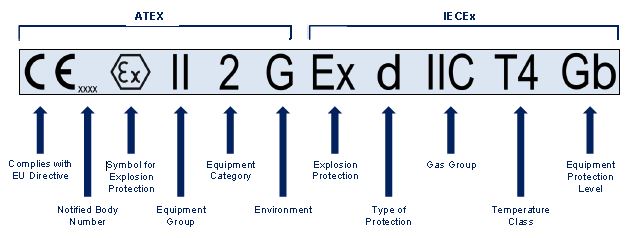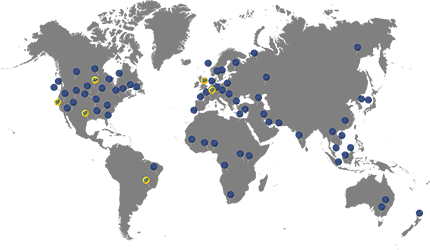 |
 |
Here is an explanation of ATEX and IECEx standards, markings, classification, directive and different zones.
ATEX products are differentiated from standard products by their markings, most noticeably the recognised Ex symbol.
Under the ATEX and IECEx schemes, products are classified and marked to show the areas in which they can be used, and the level of protection employed.
Straightpoint Ex products classifications:
ATEX – II 1 G
IECEx – ia IIC T4 Ga
Example:
For Straightpoint, current ATEX/IECEx equipment markings the protection concepts are:
ATEX – II 1 G where: Equipment Group II is for use in all other areas other than mines.
Category 1 for use Zones 0, 1 and 2 for gases/vapours.
Environment G for use in hazardous gas, vapour or mist environments.
IECEx – ia IIC T4 Ga
Type of Protection ia is Intrinsic Safety.
Gas Group IIC is gas, vapour or mist, except in coal mines.
Temperature Class T4 is up to 1350C (2480F)
Equipment Protection Level Ga – suitable for use in Zones 0, 1, 2.
Actual Straightpoint markings form part of the labels affixed to the ATEX/IECEx wireless loadcell products and held hand display unit.
In the European Union (EU) and the USA, all electrical/electronic or mechanical equipment used in explosive, or
potentially explosive atmospheres, must be manufactured to strict standards to ensure that the possibility of the equipment to cause an explosion, in both normal and abnormal operation, is minimised. This includes equipment being designed with appropriate safety devices and protection systems and being manufactured and tested under
controlled conditions. Compliance has to be verified by recognised third party professional bodies.
In the EU, the ATEX Directive defines technical and management systems requirements for compliance. In the USA and other international regions, similar requirements are specified by the IECEx scheme.
There is an accelerating growth rate for ATEX/IECEx approvals, principally driven by the upward demand for energy and growth amongst developing and emerging economies, and their increased awareness of the need for “Proof of compliance” with minimum safety standards.
Explosive Atmospheres
Under ATEX and IECEx, an explosive atmosphere is defined as a mixture of dangerous substances with air, under
atmospheric conditions, in the form of gases, vapours, mist or dust in which, after ignition has occurred, combustion
spreads to the entire unburned mixture.
Atmospheric conditions are commonly referred to as ambient temperatures and pressures. That is to say
temperatures of –20°C to 40°C and pressures of 0.8 to 1.1 bar.
Potentially explosive atmospheres can typically be found in industry sectors as:
- Onshore and offshore oil and gas rigs
- Petrochemical refineries
- Fuel distribution depots
- Oil and gas pipeline installation, repair and maintenance
- Chemical and pharmaceutical industry
- Mining
- Building, construction and civil engineering in hazardous environments
- Producers and users of solvents, paints, varnishes and other flammable liquids
- Printing and textiles
- Food manufacturers, wood processors, grain handling & storage - where dust is created
- Engineering where dust is created from machining, grinding and sanding
Organisations that operate within these and other industry sectors are obliged to assess their business activities to identify potential explosive atmospheres and to implement control measures to reduce the possibility of inadvertent explosion. Measures include using only Ex approved equipment. In the EU, this is a legal obligation.
The ATEX 2014/34/EU Directive
Also known as ATEX 95 and commonly referred to as the Equipment Directive.
The aim of the Directive (previously 94/9/EC) is to allow the free trade of 'ATEX' equipment and protective systems within the EU by removing the need for separate testing and documentation for each Member State.
It applies to both electrical and non-electrical equipment for use in potentially explosive atmospheres, which may be gas, mist, vapour or dust, above or below ground.
The directive defines essential health and safety requirements (EHSR) that need to be achieved by the manufacturer of the equipment. This usually involves testing and certification (ATEX EC-Type and/or IECEx Certificate of Conformity) by a 'third-party' certification body (known as a Notified Body) but manufacturers/suppliers can 'self-certify' equipment intended to be used in less hazardous explosive atmospheres (Category 3).
Certification ensures that the equipment or protective system is fit for its intended purpose and that adequate information is supplied with it to ensure that it can be used safely.
The directive requires that the equipment is marked to show equipment complies with the ATEX directive.
The directive also introduces categories of protection, which can be related to the zones classified by the workplace ATEX directive.
IECEx
IECEx is the International Electrotechnical Commission Scheme for Certification to Standards Relating to Equipment for Use in Explosive Atmospheres.
ATEX is driven by EU law whereas IECEx is a voluntary certification scheme. Both, however, provide an accepted means of proving compliance with IEC standards.
The difference between ATEX and IECEx is initially that ATEX is only valid in the EU and IECEx accepted globally.
Technical Standards
Both ATEX and IECEx both require compliance with the same technical standards, so in terms of technical content, there is basically no difference. The only visible difference is in many cases the marking on the device.
IEC (The International Electrotechnical Commission) Standard IEC 60079 is a suite of Standards that cover a wide standards relating to different types of equipment and protection measures in explosive atmospheres.
The applicable technical standards within this suite for Straightpoint ATEX/IECex products are:
IEC 60079-0 Explosive Atmospheres - Part 0: Equipment - General Requirements
This Standard specifies the general requirements for construction, testing and marking of electrical equipment and Ex Components intended for use in explosive atmospheres
IEC 60079-0 Explosive Atmospheres - Part 11: Equipment by Intrinsic Safety
This Standard specifies the construction and testing of intrinsically safe apparatus intended for use in an explosive atmosphere and for associated apparatus, which is intended for connection to intrinsically safe circuits which enter such atmospheres. This type of protection is applicable to electrical equipment in which the electrical circuits themselves are incapable of causing an explosion in the surrounding explosive atmospheres
IEC 60079-0 Explosive Atmospheres - Part 25: Intrinsically safe Electrical Systems
This Standard contains the specific requirements for construction and assessment of intrinsically safe electrical systems, type of protection "i", intended for use, as a whole or in part, in locations in which the use of Group I, II or III apparatus is required. This standard supplements and modifies the general requirements of IEC 60079-0 and the intrinsic safety standard IEC 60079-11
“Intrinsic Safety” is a protection technique applied to electrical equipment and wiring for hazardous locations. The technique is based on limiting electrical and thermal energy to a level below that which can cause ignition of a specific hazardous atmospheric mixture
Straightpoint ATEX/IECEx Lifting Equipment designed for lifting in hazardous areas
Ex Dynamometer load cell products available:
Radiolink plus | Wireless Loadpin | Wireless Compression | Wireless Shackle | Running Line Tensiometer




